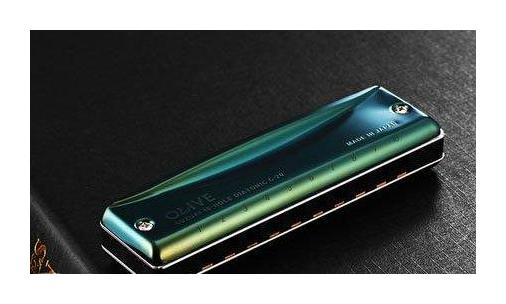十孔(BLUES)口琴把位教学
佚名 网络刚翻译一段关于十孔把位的资料,结合理解写在下面,供大家参考。后面附原文。读的时候务必注意"吹"与"吸'之分。
第一把位(1st Position):当你主要在口琴中部孔吹音演奏,而且第四孔吹音唱成1,你是在第一把位演奏,因此第一把位演奏也叫“直接演奏法”主要用来演奏曲风简单的歌曲(比如说Oh Sussanah)及大多数民谣(比如说BOB DYLAN风格的歌曲)。初学者一般可从第一把位开始学。
第二把位:当你主要在1—5孔吸音演奏,而且把第二孔吸音唱成主音1时,你实际上演奏的曲子比口琴的调高了纯五度,这时你在第二把位上演奏,以C调口琴为例子,就是演奏G调。第二把位上的演奏也叫“交cha演奏法“。这是十孔口琴最常用的把位,大多数蓝调、摇滚、乡村的十孔口琴演奏最常用第二把位。如果把第二吸孔音唱6,你实际上在演奏G小调,是bB大调的关系小调。

第三把位:当你主要在口琴中部孔(主要是4—6孔)吸音演奏,而且把第四孔的吸音当作主音时,你是在第三把位上演奏。以C调口琴为例子,第四孔吸音是D,按理说C口琴的第三把位是D调,其实这时候主音大多是唱成6的,所以应该是Dminor,也就是D小调,相当于F大调。第三把位对小调歌曲来说很合适,有些蓝调也会采用该把位。
第四把位:按照五度循环法,我们应该知道第四把位按理应该演奏比口琴的调高出9个半音(大六度)。以C调口琴为例子,按理应该演奏A调,低孔部分演奏时我们要在第三孔吸音压下2个半音才能取得,主音落在压音上是不容易演奏的。其实这情况下,我们将主音唱成6,发现其实刚好是A小调,刚好是口琴(C调)的关系小调。虽然也用来演奏一些小调歌曲及少量的蓝调,但由于主音是压音取得的,因此建议多用第三或第五把位演奏小调歌曲。当然在高音孔上演奏是方便的,也就是第六孔吸音唱6,这其实就是与第一把位一样了。看起来似乎BOB DYLAN ,NEIL YOUNG及BRUCE SPRINGSTEEN常用这把位,其实是相当于在用第一把位。我们应该明白十孔口琴最迷人的是它的1—6孔的音啊。
第五把位:第五把位按理应该是演奏比口琴的调高出4个半音(大三度)的调。以C调口琴为例子,按理应该是演奏E调,这把位上你应该第二孔吹音E作为主音,我们其实把这主音大多也唱成6,所以其实是演奏E小调,刚好是G大调(也就是第二把位)的关系小调。非常适合小调歌曲演奏,也会用在一些蓝调中。
第六—十二把位:可以根据五度圈自己推算,对初学者来说掌握上面的差不多够了。
1st Position- When you play mostly blow notes (usually in the middle portion of the harmonica) on a key of "C" harmonica you will be in the key of "C". This style of playing is called 1st position or "Straight Harp". This is commonly used for simple melodies like "Oh Sussanah" and widely used in a folk context, a la Bob Dylan. Most beginners will start with songs played in the 1st position.
2nd Position (cross harp)- When you play mostly draw notes at the low end of the harmonica (holes 1 through 5 draw), you are no longer in the key of the harmonica, but actually in a key which is a perfect 5th (or seven half-steps) up from the key of the harmonica. If you play in 2nd position on a key of "C" harmonica you will now be in the key of "G". This is the way most blues, rock, and country players will use the diatonic harmonica.
3rd Position- When you play mostly draw notes in the middle part of the harmonica (holes 4 through 6 draw), you are no longer in the key of the harmonica, but actually in a key which is a major 2nd (or two half-steps) up from the key of the harmonica. If you play in 3rd position on a key of "C" harmonica you will now be in the key of "D" (actually it would be more accurately called "D minor")。
3rd position is great for songs in minor keys and can be used in certain blues situations. Your basic starting or ending place (point of resolution) would be the 4 draw hole. The primary emphasis in playing would be the holes 4 through 6 draw. A chart is available on the Positions Chart page for determining the 3rd position key on the 12 different keys of harmonicas. 3rd Position songs page.
4th Position- With the 4th position playing style, you are no longer in the key of the harmonica, but actually in a key which is a major 6th (or nine half-steps) up from the key of the harmonica. If you play in 4th position on a key of "C" harmonica you will now be in the key of "A" (actually it would be more accurately called "A minor")。
The 4th position is not quite as easy or as useful as the 3rd position or 5th position. It can be used for songs in minor keys and can be used in certain blues situations. Because the basic starting or ending place (point of resolution) would be the 3 draw hole bent down two half-steps, it is very difficult to play in this position and make it consistently sound good. The problem is that your most important note is a bent note that is very hard to always play in tune. For this reason, we recommend the 3rd position and then the 5th position for minor playing.
Occasionally, you will find folk styled players like Bob Dylan, Neil Young, or Bruce Springsteen play in the 4th position. This is because they are playing in a minor key which is the relative minor to the (major) key of the harmonica. This style is very similar to 1st position playing, but your note of resolution (tonic) is the hole 6 draw.
5th Position- With the 5th position playing style, you are no longer in the key of the harmonica, but actually in a key which is a major 3rd (or four half-steps) up from the key of the harmonica. If you play in 5th position on a key of "C" harmonica you will now be in the key of "E" (actually it would be more accurately called "E minor")。 Although not quite as easy or as common as the 3rd position, 5th position is great for songs in minor keys and can be used in certain blues situations. Your basic starting or ending place (point of resolution) would be the 2 blow hole. A chart is available on the Basic Overview page for determining the 5th position key on the 12 different keys of harmonicas.
